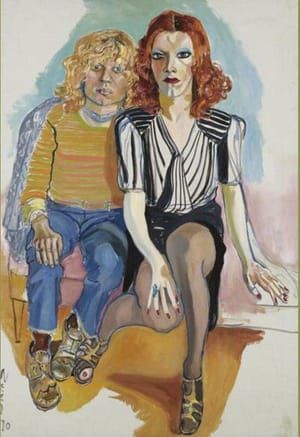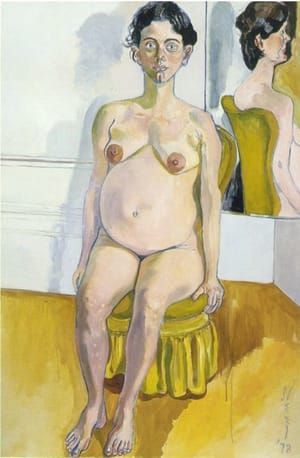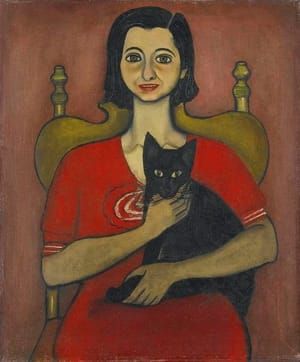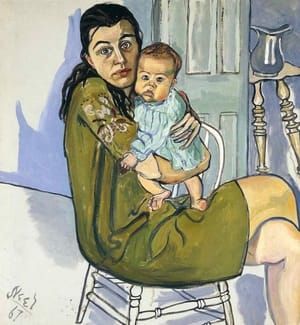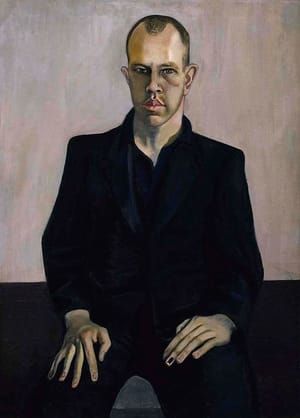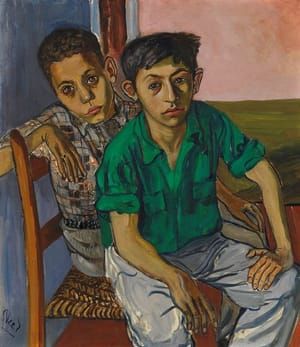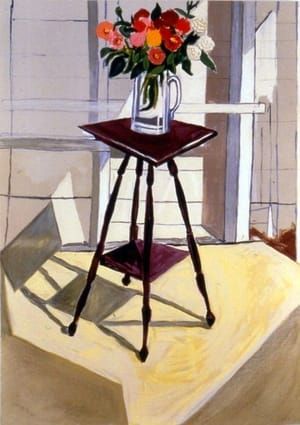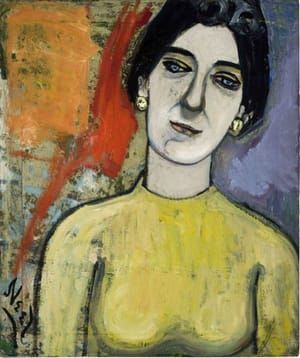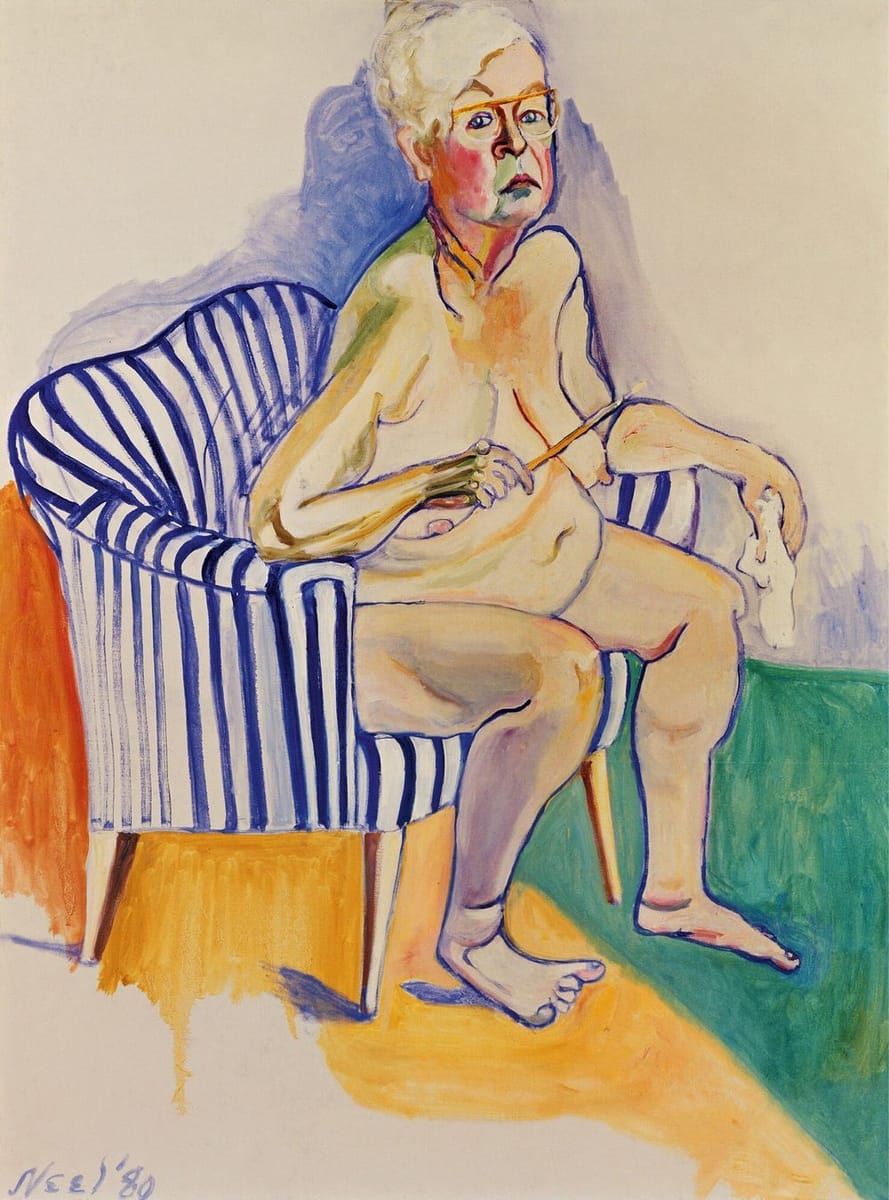

Self Portrait, 1980
Alice Neel
Neel’s most intrepid and notorious choice of subject matter for a portrait was ironically her self portrait, a customarily innocuous focus. In 1980, when Neel put her signature style and critical view to work on herself, she once more broke away from the beaten path to produce a shocking painting. Self Portrait shows Neel in her 80th year of life, seated in a familiar chair in her studio. She is shown completely naked, with nothing but her glasses, paintbrush and a rag - “her aging body equipped with just the tools of her craft.”
Her fluffy white hair reveals her ripe old age, as does the sagging flesh with its countless creases and folds. Seated comfortably yet still upright, Neel’s body is pointed away while her head turns to look straight ahead. The expression on Neel’s face is indiscernible, her eyebrows are raised inquisitively but her eyes and mouth appear almost motionless. It appears as if she is bored, tired or intensely concentrating. Her left hand hangs limply as it lets the rag dangle freely. It is interesting to note that this is the brightest white in the painting. In her right hand she holds her paintbrush erect, a motion that her raised right toe directly mirrors. The background and foreground, unfinished, show blocks of three primary colors, blue, yellow and green.
This work, completed in 1980, was incomparable for its time. Alice Neel always said that the closest she ever came to a self-portrait was the image of an empty chair by an apartment window. Eventually, at the age of 75, she begin painting this piece, but soon abandoned it. To put it differently, she had been painting for over half a century though had yet to turn her gaze on herself. Encourage by her son Richard, she returned to this piece once more in 1980 when she was invited to be part of an exhibition of self portraits at Harold Reed Gallery in New York.
Secondly, self portrait paintings were a genre that was traditionally avoided by women. And lastly, very few precedents for naked female self-portraits exist. Yet the combination of these three aspects only begins to explain the level of attention this painting garnered. Unlike her previous work, this painting is a bolder and more intense challenge to the historical convention of idealized femininity. Neel essentially depicted herself as the opposite of a pinup girl. With indelicate strokes and patches of green and red, she frankly painted her sagging breasts and lumpy belly for everyone to see. Moreover, we know that this is a reliable representation because she painted herself in the mirror. Neel, a left-handed painter, holds the brush in her right hand in the painting, the mirror image of herself.
“Frightful isn’t it?” she told Ted Castle, “I love it.” Neel continued, in her customary witty manner, “At least it shows a certain revolt against everything decent.” By choosing as the subject of her art something even she claims as indecent truly shows how unconventional Alice Neel was. Mary Garrard has a different reading of the painting in which she moves beyond the single innovative aspects to the overall wonder of one work of art being able to accomplish so much,
"She’s the subject gazing back at the viewer and she’s deploying the gaze as subject and as artist, and I think she’s very aware of all the complications of self portraiture and the gender conventions all those things - plus age. It’s not hard to break it down into all those component elements. But what’s beautiful about it is that it says it in one gestalt. It’s not like ‘Here are itemized points I am making’; it’s that the image contains, as a kind of potent object, all those ideas. I can’t think of any counterpart...It really is quite extraordinary. It’s something that is both unique and deeply in dialogue with all of art history."
The way this piece really encapsulates so much of what Neel set out to accomplish is, as Gerrard noted, quite extraordinary. This paper has already established the concept of being unique with art history as shown by the theme of pregnant nudes. What remains unaddressed is being ‘in dialogue’ with art history. Rather than just having a one-way conversation and painting unique portraits, Neel participated in an exchange of ideas with art history, borrowing information from past works and in turn, offering her own suggestions. Nevertheless, Gerrard is truly spot-on. It is as if Neel, through this painting, is saying, or rather yelling multiple messages to art history, “Women can also be artists! Women can paint self portraits! Elderly women depicted nude can be considered art! I’m going to do it all!”
An anecdote from Carolyn Carr, Deputy Director of the Smithsonian’s National Portrait Gallery is particularly useful in highlighting how groundbreaking the painting continues to be. “When I would do lectures,” Carr recalls, “I’d start with [the Portrait Gallery’s portrait of] George Washington and end with Alice. There was always a gasp when she came on the screen. Honestly because everything is sagging - but lively and energetic... That is her last, or nearly her last, painting that sort of recognizes the most powerful elements of her style, as evident in her 70’s.” The audience’s gasp of astonishment is raw proof of how the image of a naked elderly female is still not comfortably accepted. Moreover, it is still not widespread in art history. Thus, what Neel created in 1980 was so innovative that it remains fresh - almost too fresh - over 30 years later.
To critics, Neel was a difficult target to hit. Throughout her career, she attracted countless critical reviews, some flattering and some not. Yet many who reviewed Neel could not understand her work or her purpose and thus darted around her, missing the bull’s-eye. An unknown journalist for the New York Times wrote “Alice Neel’s portraits… strike somewhere between benevolent caricature and expressionism as a vehicle for personal release. But you don’t have to know exactly what Alice Neel’s target is to know that she is right on.” Though this critic tried to intellectually read Neel’s paintings, he got caught on her lack of total realism. Hilton Kramer, also writing for the New York Times, offered a backhanded compliment in his critique:
"Mrs. Neel has become somewhat of a legend on the New York art scene for her portraits. They are stress pictures, nervous and course in their drawing, often brutal in observation and completely devoid of delicacy of nuance… the coarseness of the execution supports a penetrating psychological vision. Often the pictures engage one’s interest at a level beyond - or beneath - the esthetic, and are sometimes unforgettable in a way that much finer pictures are not."
(Continued at http://www.americansc.org.uk/Online/Online_2012/neel.html)
Uploaded on Jul 16, 2017 by Suzan Hamer
Alice Neel
artistArthur
Wait what?

